MercoPress. South Atlantic News Agency
Their Grave is the Sea - 1914 Naval Battles: Coronel and Falklands
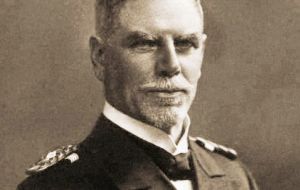 Vice Admiral Graf von Spee
Vice Admiral Graf von Spee 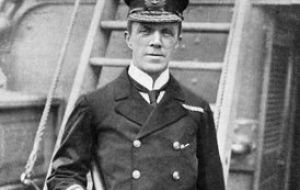 Rear-Admiral Sir Doveton Sturdee.
Rear-Admiral Sir Doveton Sturdee. 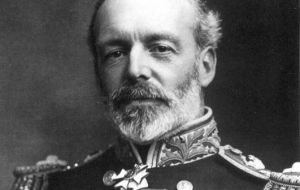 Rear-Admiral Sir Christopher Cradock
Rear-Admiral Sir Christopher Cradock 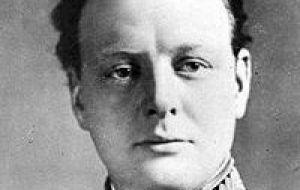 Winston Churchill, First Lord of the Admiralty
Winston Churchill, First Lord of the Admiralty 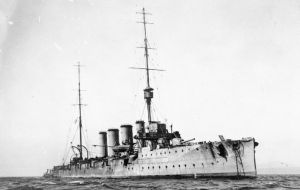 HMS Glasgow commanded by Captain John Luce which took part in both battles and in the search for Dresden.
HMS Glasgow commanded by Captain John Luce which took part in both battles and in the search for Dresden. By Harold Briley (*) Early in World War One the Royal Navy suffered one of its most disastrous defeats followed five weeks later by one of its most decisive victories. In the Battle of the Falkland Islands on 8 December, 1914, all five battle cruisers of the German East Asian Squadron and its support ships were defeated with nearly 2,000 men killed including their commander, Vice Admiral Graf von Spee. No British ships were lost and only eight British sailors were killed.
The battle avenged the Royal Navy’s most disastrous defeat for over a hundred years in the Battle of Coronel off the coast of Chile on 1 November, 1914. Graf von Spee’s squadron sank two cruisers Good Hope and Monmouth, the first British warships of any size sunk by enemy gunfire with all hands lost. More than 1,600 died including their commander, Rear-Admiral Sir Christopher Cradock. The Falkland Islands gold reserves of £3,750 lent by the Governor to Cradock also went down with his ship. He had fallen foul of the setting sun which plunged the Germans into darkness while silhouetting his own ships, a scenario he had warned against in a battle instruction handbook. Two other ships Otranto and Glasgow, with a gaping hole in her stern, were forced to withdraw. The Kaiser awarded Graf Spee and his men 300 Iron Crosses.
Winston Churchill, First Lord of the Admiralty, took a personal interest in the hunt for Graf von Spee’s squadron hiding in the vast expanse of the Pacific Ocean, where it was a threat to commercial shipping and to troopships sailing to Europe from Australia and New Zealand. The Admiralty deployed a powerful force to the South Atlantic - eight cruisers, Invincible, Inflexible, Carnarvon; Cornwall, Kent, Bristol, Glasgow, and Macedonia, and the battleship Canopus, under the command of Rear-Admiral Sir Doveton Sturdee. His orders were to pursue and destroy the German squadron.
Its cruisers, Scharnhorst, Gneisenau, Dresden, Nurnberg and Leipzig and three supply ships rounded Cape Horn and, on their way back to Germany, von Spee, decided to attack and destroy the Falkland’s base installations, which he believed to be undefended. The Governor, William Allardyce, ordered the evacuation of 500 women and children from Stanley into the countryside.
Admiral von Spee was shocked to find the powerful British force had arrived in Falklands only the previous day. Sturdee was equally surprised as his ships were unready for battle, still taking on thousands of tons of coal to fire their steam boilers. They were trapped and faced annihilation. Canopus had been driven five feet deep into mud to provide a stable platform for her heavy guns.
Winston Churchill is quoted as saying that the outcome of the battle gave him one of his most anxious periods in two World Wars. He was misled by an ambiguous signal from Governor Allardyce from which he wrongly inferred that the British ships had been destroyed. But second message hours later told him: “It’s all right, Sir, they are all at the bottom”, meaning the German fleet. Instead of attacking, von Spee beat a rapid retreat, a fatal mistake for the Germans and salvation for the British.
Sturdee’s force set off in pursuit. Within a few hours Scharnhorst, Gneisenau, Nurnberg, Leipzig and two supply transports, Baden and Santa Isabel, were sunk. Dresden escaped but three months later, in March 1915, she was found sheltering in Chilean waters by Kent and Glasgow, and was scuttled. The surviving German supply ship, Scydlitz, was interned by Argentina. All von Spee’s eight ships were accounted for. A pig given to Dresden’s crew by the German community in Chile swam ashore, was captured as a war trophy, re-christened Tirpitz, and raffled several times for the war effort. It died of old age and its stuffed head was put on display in the Imperial War Museum in London.
Sturdee was knighted and later commanded ships in the 1917 Battle of Jutland. The Admiralty gave £10,000 to Sturdee and £12,160 in prize bounty to be shared among the crews of the battle cruisers.
Churchill’s gamble of sending so many powerful warships so far away weakened Britain’s defence against invasion. The German High Seas Fleet seized the opportunity to send a squadron across the North Sea on 16 December to bombard Hartlepool, Scarborough and Whitby, killing 137 people and injuring 592, a consequence of a battle 8,000 miles away.
A memorial statue in Stanley commemorates Admiral Sturdee’s victory, and a new memorial wall has been built nearby for the hundredth anniversary to commemorate the Battle of Coronel.
To mark the anniversary, the battles were being commemorated in ceremonies in Chile, the Falkland Islands and London with a memorial service in St Martin- in- the- Fields, the Royal Navy Church in Trafalgar Square. Descendants of crew members were invited to take part. The Falkland Islands Government minted a new £2 coin depicting HMS Glasgow commanded by Captain John Luce which took part in both battles and in the search for Dresden.
A film about the battle, made in 1927, described as one of the best war films ever made, starring Royal Navy ships, has been refreshed by the British Film Institute for the 100th anniversary.
(*) Harold Briley, former BBC Latin America and Defence Correspondent




Top Comments
Disclaimer & comment rules-

-

-

Read all commentsIt's a very interesting piece of history.
Dec 08th, 2014 - 02:31 pm 0Statements by the key participants were recorded along the motivations for their actions. One could not but believe that Admiral Cradock was forced against his better judgment to engage what he knew to be a superior force and by chance, found himself in a disadvantageous position, as well as in foul weather that handicapped his ability to fight.
Admiral von Spee did exactly what he needed to do and his well trained crews sank two British cruisers. However, by using up so much ammunition, they became vulnerable to any further confrontation.
von Spee should have been wary of any further engagements and avoid the Falkland Islands altogether. He had plenty of coal, so he might have been able to reach the German colonies in Africa to refuel. What he lacked was sufficient ammunition for a sustained action.
Some suggest that von Spee was lured into making an attack on Stanley by radio message. This might be true. However, what is indisputable is that he made a classic error of not pressing home his attack when he discovered the presence of British Battlecruisers.
This mistake repeated many years later, when Captain Hans Langsdorff failed to press home his advantage against the British cruisers Ajax & Achilles at the Battle of the River Plate.
You see, von Spee could see that the British cruisers were in Stanley harbour. It was logical to assume that they were not ready for battle and this was so. If von Spee had blocked the narrows, the entrance to Stanley harbour, even scuttling one of his ships there, then von Spee could have trapped the British fleet and then escaped, or sunk them at their moorings.
Instead he ran, in ships that were much slower and was caught and sunk by the British fleet.
Langsdorff faced the same problem and also ran. If he had sunk Ajax & Achilles, then he would have been able to sail to Buenos Aires and repair his fuel pump to escape. Instead he scuttled his ship - the Admiral Graf Spee.
Irony.
The Punta Arenas cemetery - well worth a visit in its own right - has an interesting and rather surreal memorial to the German sailors with black-painted shell casings and much German insignia , etc - all rather gothic in style I thought.
Dec 09th, 2014 - 01:09 am 01#
Dec 09th, 2014 - 04:16 am 0It's a very interesting piece of history.
Yes it is and your post is an excellent summary and makes compelling reading.
The comparison between the two naval battles, Falkland Islands in WW1 and the River Plate in WW2 is ironic.
Thank you.
Commenting for this story is now closed.
If you have a Facebook account, become a fan and comment on our Facebook Page!